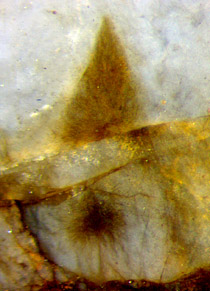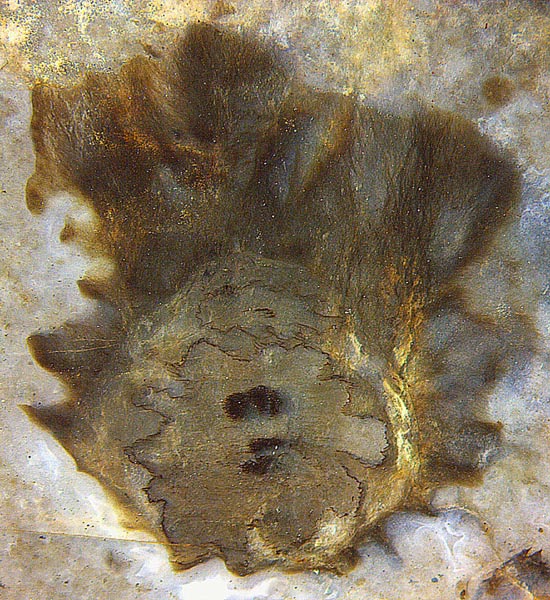Croftalania
aspects
The cyanophyte
Croftalania
[1] is found in the Rhynie chert as
filaments and bulky tufts thereof, grown on
substrates like silica gel surfaces or decaying plants in the
swamp water. They are formed in a surprising variety of ways so
that some of the shapes may resemble vegetables or styled hair. Several
examples have
been presented here: Rhynie
Chert News
56,
72,
125.
The present contribution is meant to offer more of them.
Inconspicuous separate filaments
in Rhynie
Chert News
80, 144 are probably Croftalania
but attention is drawn here to the conspicuous agglomerated masses of
filaments.

 What looks like a monstrous face with excessive hair growth in Fig.1 is
three bulky tufts of filaments
growing outward from their
site of attachment at the outside of a tube, probably
of a charophyte alga. More often the tufts look as if trimmed by means
unknown into wondrous shapes with distinct boundaries as in Figs.2,3.
What looks like a monstrous face with excessive hair growth in Fig.1 is
three bulky tufts of filaments
growing outward from their
site of attachment at the outside of a tube, probably
of a charophyte alga. More often the tufts look as if trimmed by means
unknown into wondrous shapes with distinct boundaries as in Figs.2,3.

Fig.1 (far left): Filamentous
cyanophyte Croftalania
grown in dense tufts on
the surface of a cylindrical alga part. Image width 1mm.
Fig.2 (left): Croftalania tuft
of filaments grown on a decaying
plant part, trimmed into an "unnatural" shape.
Image width 0.7mm.
Fig.3 (right): Fancy composition: Croftalania grown
on a shrivelled early land plant, probably Nothia, lying in
swamp water. Image width 5mm.
Apparently the
early land plant cross-section with
a thin black coating along the epidermis seen clearly in Fig.3, upset in
the swamp water, had become coated
with silica gel, which served as a substrate for Croftalania growing from there mostly upward towards the light.
(The upward direction is indicated by level fills
in former cavities
in the same chert sample.)
By comparison with the diffuse boundary in Fig.1, the rather smooth
periphery in Fig.3,
including pointed tips, requires an explanation. Feeding
crustaceans
nibbling off the tuft ends smoothly had been proposed
as a thinkable explanation of the clear-cut boundaries but doubts have
remained. So it appears again that fossiliferous cherts do not only provide news but pose new problems as well.
Samples: Fig.1: Rh15/82 (0.19kg),
Part 2, obtained from Barron in 2014.
Figs.2,
3: Rh2/19 (8.3kg), Part 4: slab
12-14mm, found in 2001.
.
H.-J.
Weiss 2023
[1]
M. Krings, H. Kerp, H. Hass, T.N. Taylor, N.
Dotzler:
A filamentous
cyanobacterium showing structured colonial growth from the
Early Devonian Rhynie chert.
Rev. Palaeobot.
Palyn. 146(2007), 265-276.
 |
 |
191 |



 What looks like a monstrous face with excessive hair growth in Fig.1 is
three bulky tufts of filaments
growing outward from their
site of attachment at the outside of a tube, probably
of a charophyte alga. More often the tufts look as if trimmed by means
unknown into wondrous shapes with distinct boundaries as in Figs.2,3.
What looks like a monstrous face with excessive hair growth in Fig.1 is
three bulky tufts of filaments
growing outward from their
site of attachment at the outside of a tube, probably
of a charophyte alga. More often the tufts look as if trimmed by means
unknown into wondrous shapes with distinct boundaries as in Figs.2,3. 

